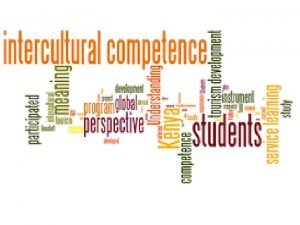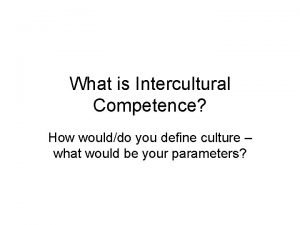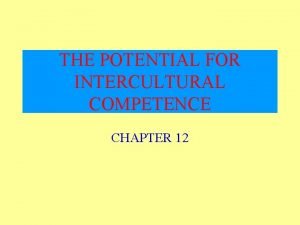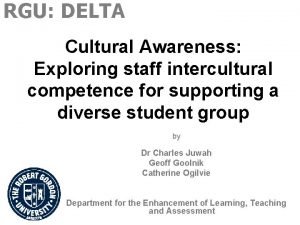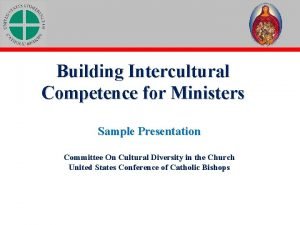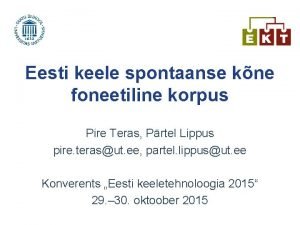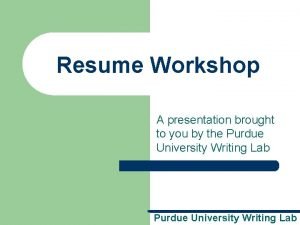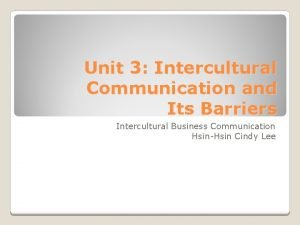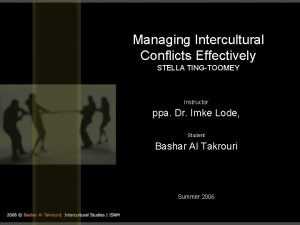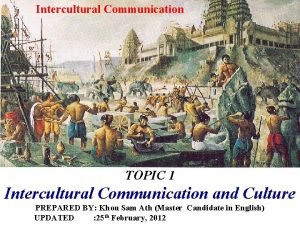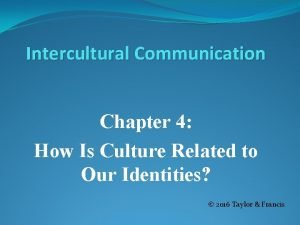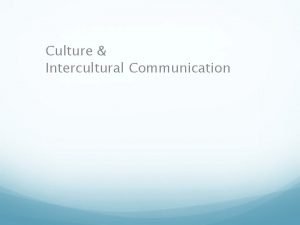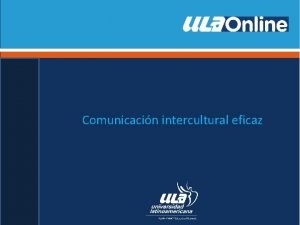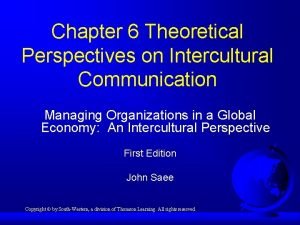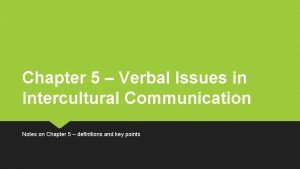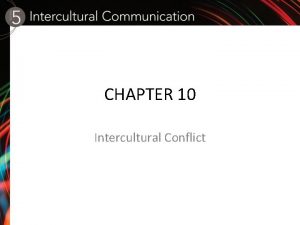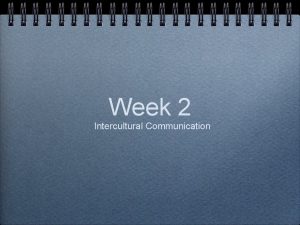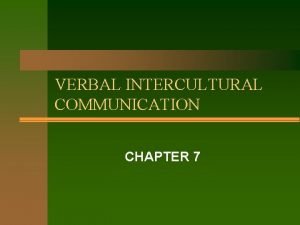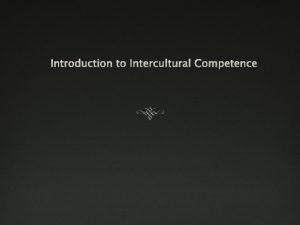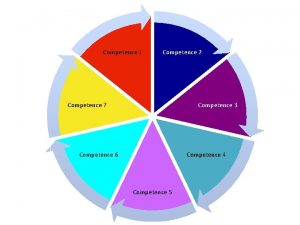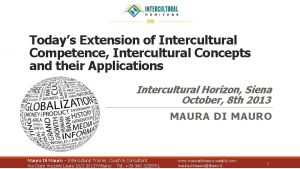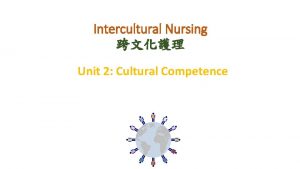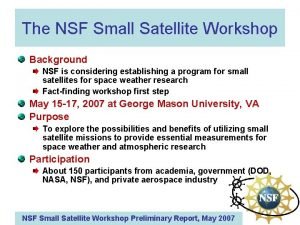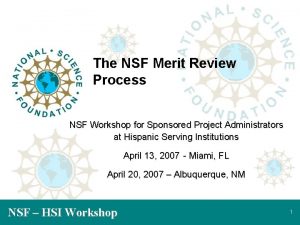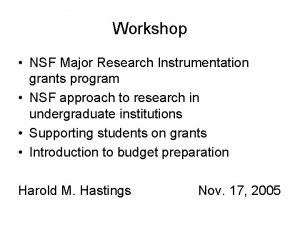INTERCULTURAL COMPETENCE PRESENTATION TO NSF PIRE WORKSHOP FACULTY























- Slides: 23

INTERCULTURAL COMPETENCE PRESENTATION TO NSF PIRE WORKSHOP FACULTY AFFAIRS, KAREN ZENTNER BACIG, PH. D. INSTRUCTOR, HUMPHREY SCHOOL OF PUBLIC UNIVERSITY OF MINNESOTA FOUNDER &CONSULTANT, SABIO STRATEGIES WASHINGTON, DC APRIL 24, 2013

GOAL FOR TODAY’S SESSION Ø Discuss culture and intercultural competence Ø Introduce Bennett’s Developmental Model of Intercultural Sensitivity (DMIS) and Hammer’s Adaptation of DMIS – Intercultural Competence Model (ICM) Ø Introduce measures of intercultural competence ü Intercultural Development Inventory (IDI) ü AAC&U rubric ü Kozai Intercultural Effectiveness Scale (IES) Ø Explore Kozai Intercultural Effectiveness Scale (IES) Ø Discuss the development of intercultural competence – What do we know from the research?

CULTURE “…the way people think, feel, and act…. ‘the collective programming of the mind distinguishing the members of one group or category of people from another’…. A simpler definition is ‘the unwritten rules of the social game’. Source: Geert Hofstede, http: //geerthofstede. nl/culture. aspx Image source: James Penstone, http: //opengecko. com/interculturalism/visualising-the-icebergmodel-of-culture/

SOME ASPECTS OF CULTURE Ø Orientation to people – Individualism vs. Collectivism Ø Orientation to responsibility – Universalism vs. Particularism Ø Orientation to time – Monochronic vs. Polychronic Ø Orientation to context – High vs. Low Context Source: What’s Up With Culture? , http: //www 2. pacific. edu/sis/culture/

WHAT IS INTERCULTURAL COMPETENCE? DEFINITIONS Set of cognitive, affective, and behavioral skills and characteristics that support effective and appropriate interaction in a variety of cultural contexts. (Source: Bennett, J. M. , 2008) Ability to communicate effectively and appropriately in intercultural situations based on one’s intercultural knowledge, skills, and attitudes. (Source: Darla K. Deardorff. Based on first study to document definition consensus among leading intercultural experts. )

WHAT IS INTERCULTURAL COMPETENCE? A Mind set Knowledge A Skill set Abilities A Heart set Attitudes Source: J. Bennett, 2006.

DEVELOPING INTERCULTURAL COMPETENCE: FOUR LEVELS OF CULTURAL AWARENESS Moving people from 1) unconscious incompetence to 2) conscious incompetence to 3) conscious competence, and finally, to 4) unconscious competence. Source: http: //www 2. pacific. edu/sis/culture/pub/1. 6. 2_the_four_level_of_cul. htm, based on work by William Howell.

CULTURAL AWARENESS Increasing cultural awareness leads to an understanding of: ØWorld view – We each have one and they are not all the same. And the ability to engage in: ØPerspective-taking – Ability to see things from other world views.

INTERCULTURAL COMPETENCE – WHY DOES IT MATTER? When we encounter differences that make a difference, the ability to see, experience, and understand culture in increasingly sophisticated and complex ways enhances the effectiveness of our interactions and our work together.

BENNETT’S DEVELOPMENTAL MODEL OF INTERCULTURAL SENSITIVITY (DMIS) “A framework for analyzing the potential response to cultural difference. . . ” Underlying assumption: “…as one’s experience of cultural difference becomes more complex and sophisticated, one’s competence in intercultural relations increases. ” (Source: J. Bennett, 2004, p. 158) ØDenial ØDefense ØMinimization ØAcceptance ØAdaptation ØIntegration (not included in Hammer’s adapted model)

INTERCULTURAL COMPETENCE MODEL (ICM) Bridges Across Difference Deeply Comprehends Difference De-emphasizes Difference Judges Difference Misses Difference Transition stage between monocultural and intercultural mindset Source: Reproduced from the Intercultural Development Inventory Resource Guide by permission of the author, Mitchell R. Hammer, Ph. D. , IDI, LLC. Copyright 1998, 2003, 2007, 2012 Mitchell R. Hammer, IDI, LLC. All Rights Reserved.

AAC&U VALUE RUBRICS Ø Valid Assessment of Learning in Undergraduate Education (VALUE) Ø 15 rubrics developed by teams of faculty experts as part of an Association of American Colleges and Universities (AAC&U) initiative Ø Intercultural knowledge and competence rubric informed by Bennett’s (1993) Developmental Model of Intercultural Sensitivity (DMIS) and Deardorff’s Intercultural Framework of Intercultural Competence (2006). Ø Direct measure of intercultural knowledge and competence.

AAC&U INTERCULTURAL KNOWLEDGE AND COMPETENCE RUBRIC Knowledge � Cultural self-awareness � Knowledge of cultural worldview frameworks Skills � Empathy � Verbal and nonverbal communication Attitudes � Curiosity � Openness

IES – AN INTRODUCTION Ø Used across education, government, business, and nonprofit sectors Ø Derived from a larger instrument, the Global Competencies Inventory (GCI) Ø Comparison group of thousands – variety of educational levels, ages, industry sectors, races/ethnicities, countries of origin, etc. Ø Measures competencies – how well a person manages intercultural differences Ø Developed from expatriate and global leadership literature

IES The IES examines three factors, each consisting of two competencies. Continuous Learning Interpersonal Engagement Hardiness Exploration Global Mindset Positive Regard Self- Awareness Relationship Interest Resilience An Overall IES score is generated by combining the scores of the six sub-dimensions. 15 Source: Kozai Group

IES – EXAMPLE INDIVIDUAL PROFILE 16

IES – TELLS US…? 17

IDI AND IES One way to think about these assessments: Ø IDI can tell you where you are on your developmental journey relative to how you experience difference Ø IES can tell you how you respond to difference you will do on the journey - how

A FEW THINGS WE KNOW ABOUT DEVELOPING INTERCULTURAL COMPETENCE Cultural knowledge does not necessarily lead to competence. Cultural contact does not necessarily lead to competence. Cultural contact may lead to reduction of stereotypes. Language learning may not be sufficient for cultural learning. Source: Kozai Group

CAN INTERCULTURAL COMPETENCE BE TAUGHT? YES! Ø Ø Ø Intentional and developmentally sequenced program design. Balancing challenge and support; anxiety reduction. Facilitating learning before, during, and after intercultural experiences. Depth of intercultural experiences, language immersion. Intercultural competence training. Cultivating curiosity and cognitive flexibility. Source: Kozai Group

DEVELOPING INTERCULTURAL COMPETENCE Ø Reflection – journals, discussions Ø Assessments – e. g. , IDI, IES Ø Direct feedback – e. g. , AAC&U VALUE rubric Ø Working in diverse teams Ø Opportunities for practice Ø Immersion experiences – “crucible” experiences Ø Intentional opportunities throughout – before, during and after – e. g. , What’s Up With Culture website Ø Knowledge – e. g. , self, other cultures

SELECTED RESOURCES Assessments IES – http: //kozaigroup. com/inventories/the-interculturaleffectiveness-scale/ IDI – www. idiinventory. com AAC&U VALUE Rubrics – http: //www. aacu. org/value/rubrics/ Preparation for study abroad What’s Up With Culture? website http: //www 2. pacific. edu/sis/culture/

THANK YOU! Karen Zentner Bacig, Ph. D. kbacig@umn. edu
 Elements of intercultural competence
Elements of intercultural competence Define intercultural competence
Define intercultural competence Behavioral assessment scale for intercultural competence
Behavioral assessment scale for intercultural competence Rgu delta
Rgu delta Building intercultural competence for ministers
Building intercultural competence for ministers Pire teras
Pire teras Amazon pire
Amazon pire Business strategy workshop presentation
Business strategy workshop presentation Business continuity plan presentation
Business continuity plan presentation Mountain jacks lafayette indiana
Mountain jacks lafayette indiana Prejudice barrier in communication
Prejudice barrier in communication Managing intercultural conflict effectively
Managing intercultural conflict effectively Kyra garson
Kyra garson Kim's model of intercultural conflict
Kim's model of intercultural conflict Example of a low context culture
Example of a low context culture Questions about intercultural communication
Questions about intercultural communication Avowal intercultural communication
Avowal intercultural communication Youtube intercultural communication
Youtube intercultural communication Interculturalidad significado
Interculturalidad significado Intercultural miscommunication theory
Intercultural miscommunication theory Intercultural communication notes
Intercultural communication notes Kim's model of intercultural conflict
Kim's model of intercultural conflict Staircase model of intercultural communication
Staircase model of intercultural communication Example of verbal intercultural communication
Example of verbal intercultural communication
